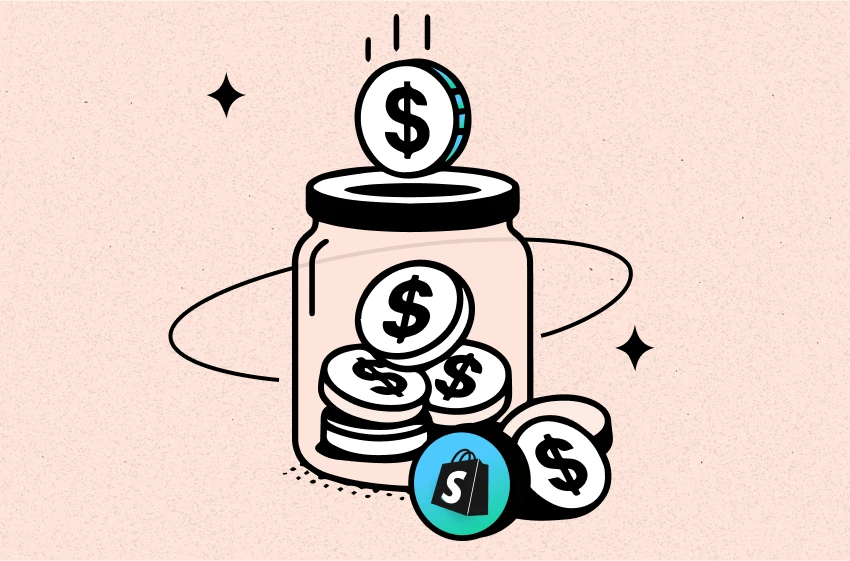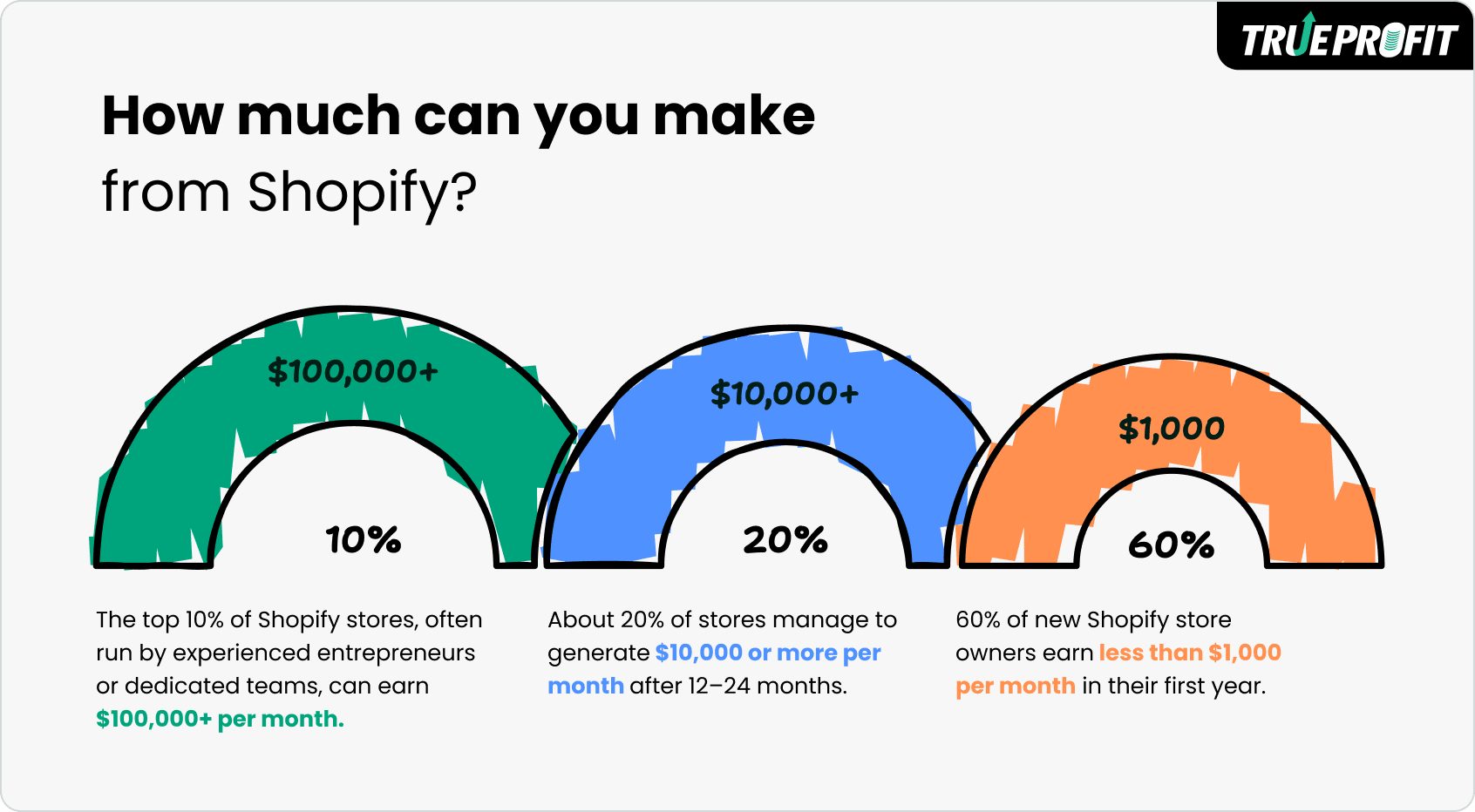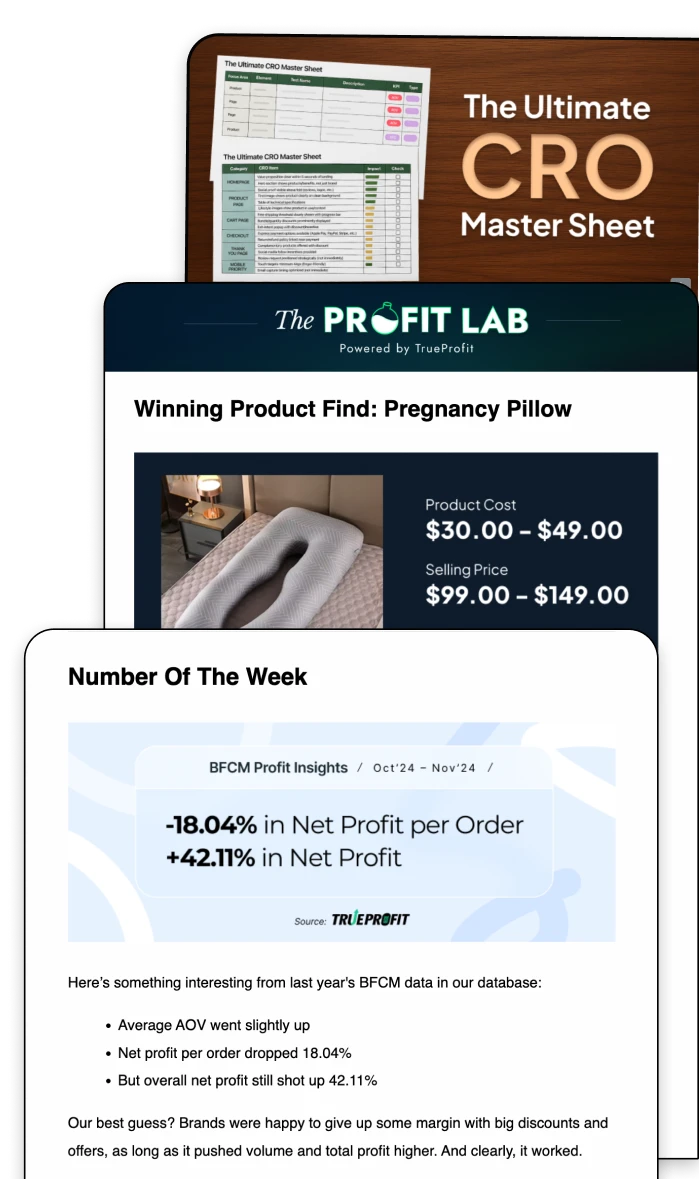How Much Can You Make from Shopify? Real Numbers + Proven Tips

How much can you make from Shopify? The reality: 60% of new stores earn under $1,000/month, but 20% hit $10,000+ monthly after consistent effort. The top 10% make $100,000+ per month.
Your earnings depend on your business model—dropshipping ($500-$5,000/month), print-on-demand ($300-$3,000/month), or branded ecommerce ($2,000-$50,000+/month). Success isn't guaranteed, but it's achievable with the right strategy.
Below, we'll show you real store examples, actual profit breakdowns, and the proven steps to scale from zero to six figures.
Shopify Success Depends on Your Business Model
Before we talk numbers, you need to understand that Shopify isn’t a business model — it’s a platform. The income you can generate depends heavily on the type of business you run:
- Dropshipping: Low startup costs, but lower margins. The seller doesn't handle inventory, which simplifies logistics. However, reliance on suppliers can lead to fulfillment delays and lower product quality. Average profits: $500–$5,000/month for beginner stores.
- Print-on-Demand (POD): Similar to dropshipping but with more customization. You're selling unique designs on t-shirts, mugs, and other merchandise without holding inventory. POD shops are great for creatives, but success often hinges on building a niche brand. Average profits: $300–$3,000/month.
- Private Label/Ecommerce Brands: Higher upfront investment, but scalable with better margins. This model involves manufacturing or sourcing products under your own brand. These stores take more time to set up but often evolve into sustainable businesses. Average profits: $2,000–$50,000+/month.
- Digital Products/Courses: High margins, minimal overhead. Think eBooks, templates, and online courses. These stores often run on autopilot after the initial setup. Profits vary widely, from $500 to over $100,000/month for top creators.
Choose the model that aligns with your skills, capital, and long-term goals.
How Much Do Shopify Store Owners Really Make? (With Data)


Shopify doesn't publicly share earnings data for individual stores, but third-party research, surveys, and case studies offer valuable insights into what sellers can realistically expect to earn.
- 60% of new Shopify store owners earn less than $1,000 per month in their first year. This is especially common among solo entrepreneurs who invest little in paid advertising, product research, or conversion optimization. Many use this phase for testing products, learning the platform, and building brand presence.
- About 20% of stores manage to generate $10,000 or more per month after 12–24 months. These businesses typically engage in consistent marketing efforts, optimize their storefronts for conversion, and use analytics to refine their product offerings.
- The top 10% of Shopify stores, often run by experienced entrepreneurs or dedicated teams, can earn $100,000+ per month. These stores usually benefit from niche dominance, strong brand identity, and scalable fulfillment systems.
You might be wondering:
How much do Shopify store owners have to spend each month?
The core Shopify fees you'll need to cover are:
- Shopify subscription: $39 (Basic) to $399 (Advanced), depending on features and scale.
- Shopify apps & tools: $50–$300 for tools like email marketing platforms, review apps, upsell apps, analytics add-ons and post-purchase platforms.
- Advertising: $500–$10,000+ across platforms like Meta (Facebook/Instagram), TikTok, and Google. Ad spend is typically the largest variable cost and essential for scaling.
- Fulfillment & shipping: Costs vary significantly based on product weight, shipping zones, and fulfillment method (e.g., self-fulfillment vs. third-party logistics).
- Other fees: $100–$500 for domains, freelance help (design, copywriting), product photography, or business tools.
These are recurring monthly costs, and managing them well is crucial to achieving profitability. Many successful store owners reinvest early profits into paid traffic, branding, and improving the customer experience to fuel long-term growth.
Key Factors That Affect Your Shopify Income
1. Product Selection & Market Demand
Choosing products with strong demand and low competition is essential. For instance, a niche skincare brand offering targeted solutions can attract high conversion rates from passionate audiences.
2. Pricing & Profit Margins
Pricing directly impacts how much you actually take home. High-margin products give you flexibility for ad spend and discounts while maintaining profit after shipping, fees, and advertising.
3. Traffic & Marketing Strategy
Combining organic SEO with paid channels—Meta, TikTok, Google—drives sustainable traffic. A skincare store example: launching a referral program offering 20% off to both referrer and referee resulted in 12% of new sales through referrals, with a fraction of the cost of paid ads.
4. Conversion Optimization
The design and usability of your site—fast loading pages, clear product details, mobile responsiveness, and trust signals (e.g. reviews)—can dramatically lift conversion rates.
5. Customer Retention & Repeat Business
Retaining existing customers is more cost-efficient than acquiring new ones. Automated email flows (welcome series, VIP offers, replenishment reminders) and tiered loyalty programs can significantly boost customer lifetime value over time.
How To Scale Your Shopify Stores?
Scaling your Shopify store requires strategic planning and systematic execution. Focus on these key areas to drive sustainable growth:
- Optimize your technical foundation by ensuring fast page load speeds, mobile responsiveness, and proper SEO optimization. A solid technical base can handle increased traffic without performance issues.
- Diversify your marketing channels beyond a single traffic source. Combine paid advertising (Facebook, Google, TikTok), email marketing automation, content marketing, and influencer partnerships to reduce dependency on any one channel.
- Streamline operations with inventory management software, automated fulfillment processes, and customer service tools. Consider partnering with 3PL providers as order volumes increase to maintain fast shipping times.
- Focus on data-driven decisions by tracking key metrics like customer lifetime value, average order value, and conversion rates. Use Shopify Analytics and Google Analytics to identify your most profitable traffic sources and products.
- Implement growth strategies such as upselling and cross-selling, loyalty programs, and strategic product line expansions. Increase average order values through bundles and free shipping thresholds.
- Build your team gradually by delegating repetitive tasks to virtual assistants or freelancers first, then hiring specialists in marketing, operations, or customer service as revenue grows.
Success comes from balancing growth initiatives with profitability, ensuring each scaling effort contributes positively to your bottom line while maintaining excellent customer experience.
Risks and Hidden Costs You Need to Know
While Shopify is profitable for many, it’s not without risks:
- Ad Burnout: Platforms like Facebook and TikTok constantly shift. What works today might flop tomorrow.
- Refunds/Chargebacks: These can eat into your margins quickly. Always have a clear return policy and responsive customer support.
- Overreliance on One Traffic Source: Diversify early to avoid sudden drops in sales.
- Scaling Too Fast: Going viral sounds great, but inventory shortages or poor customer service can cripple your reputation.
- Tool Fatigue: Paying for too many apps can silently erode your profits. Audit regularly.
Approach your Shopify business with a balanced mindset — growth with caution.
Final thoughts
So, how much can you make from Shopify? The truth is—it varies.
The average Shopify revenue might be a few hundred dollars a month, while others bring in six figures or more. Your income depends on what you sell, how well you market it, and how effectively you manage your costs.
The good news? With the right tools and strategy, building a profitable Shopify business is within reach. Tools like TrueProfit help you track your real profits in real time, so you're not just guessing—you’re growing smarter.
Lila Le is the Marketing Manager at TrueProfit, with a deep understanding of the Shopify ecosystem and a proven track record in dropshipping. She combines hands-on selling experience with marketing expertise to help Shopify merchants scale smarter—through clear positioning, profit-first strategies, and high-converting campaigns.



 Shopify profits
Shopify profits